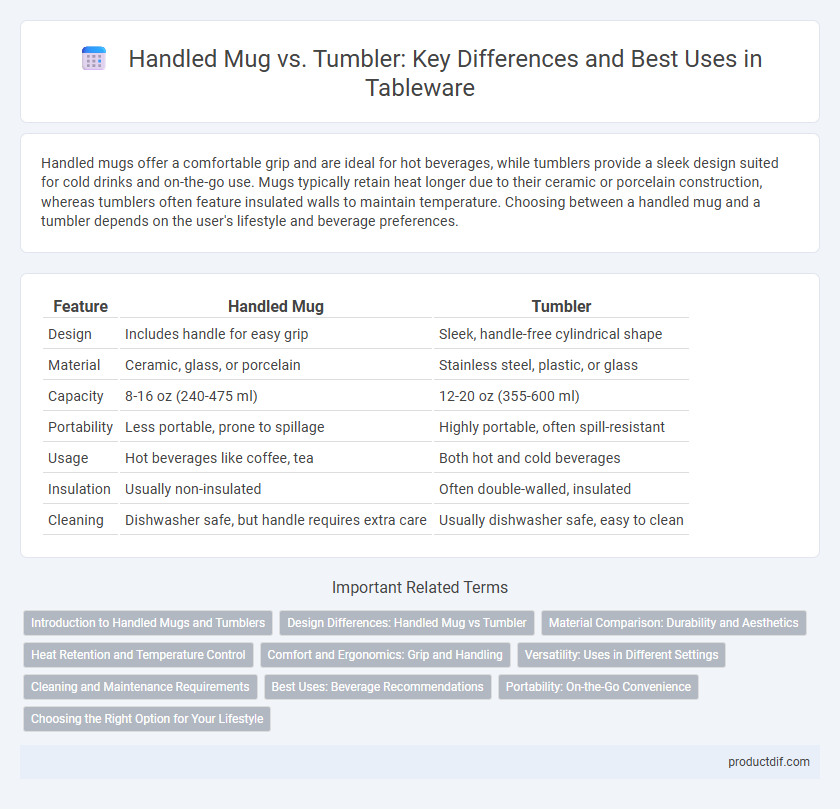Handled mugs offer a comfortable grip and are ideal for hot beverages, while tumblers provide a sleek design suited for cold drinks and on-the-go use. Mugs typically retain heat longer due to their ceramic or porcelain construction, whereas tumblers often feature insulated walls to maintain temperature. Choosing between a handled mug and a tumbler depends on the user's lifestyle and beverage preferences.
Table of Comparison
| Feature | Handled Mug | Tumbler |
|---|---|---|
| Design | Includes handle for easy grip | Sleek, handle-free cylindrical shape |
| Material | Ceramic, glass, or porcelain | Stainless steel, plastic, or glass |
| Capacity | 8-16 oz (240-475 ml) | 12-20 oz (355-600 ml) |
| Portability | Less portable, prone to spillage | Highly portable, often spill-resistant |
| Usage | Hot beverages like coffee, tea | Both hot and cold beverages |
| Insulation | Usually non-insulated | Often double-walled, insulated |
| Cleaning | Dishwasher safe, but handle requires extra care | Usually dishwasher safe, easy to clean |
Introduction to Handled Mugs and Tumblers
Handled mugs, typically crafted from ceramic or porcelain, offer a comfortable grip and are ideal for holding hot beverages like coffee or tea due to their insulating properties and ergonomic handle design. Tumblers, often made from glass, stainless steel, or plastic, feature a cylindrical shape without handles, making them versatile for both hot and cold drinks while emphasizing portability and durability. Choosing between handled mugs and tumblers depends on the need for heat insulation, ease of handling, and the intended beverage type.
Design Differences: Handled Mug vs Tumbler
Handled mugs feature a distinctive handle for easy gripping and are typically designed for hot beverages, offering insulation and comfort during use. Tumblers lack handles and usually have a cylindrical shape with double-walled construction to maintain temperature, ideal for both cold and hot drinks. The design of handled mugs prioritizes ergonomic holding, while tumblers emphasize portability and temperature retention.
Material Comparison: Durability and Aesthetics
Handled mugs typically feature ceramic or porcelain materials known for their durability and classic aesthetic appeal, providing excellent heat retention and a comfortable grip. Tumblers are often made from stainless steel or glass, offering superior impact resistance and modern, sleek designs that appeal to contemporary tastes. Both materials balance durability and style, but handled mugs excel in traditional warmth while tumblers prioritize portability and resilience.
Heat Retention and Temperature Control
Handled mugs provide superior heat retention compared to tumblers due to their thicker ceramic or porcelain walls, which insulate hot beverages longer. Tumblers, often made from stainless steel with vacuum insulation, excel at maintaining both hot and cold temperatures for extended periods, ensuring precise temperature control. The handle on mugs prevents heat transfer to hands, enhancing comfort, while tumblers rely on insulated exteriors to minimize heat loss and prevent condensation.
Comfort and Ergonomics: Grip and Handling
Handled mugs provide superior comfort and ergonomics due to their secure grip, allowing users to hold hot beverages without discomfort or risk of slipping. Tumblers, lacking handles, rely on the contoured body or textured surface for grip, which may be less comfortable during prolonged use, especially with hot liquids. Ergonomic design in handled mugs minimizes strain on fingers and wrist, enhancing overall ease of handling compared to tumblers.
Versatility: Uses in Different Settings
Handled mugs offer versatility suited for hot beverages like coffee and tea, ideal in office or home settings where warmth retention and ease of handling matter. Tumblers excel in casual or outdoor environments, designed for cold drinks and often featuring spill-resistant lids and insulation for temperature retention. Both tableware options adapt to varying lifestyle needs, with handled mugs emphasizing comfort and tumblers prioritizing portability and durability.
Cleaning and Maintenance Requirements
Handled mugs typically require more careful cleaning due to their handles, which can trap residue and require thorough scrubbing to prevent buildup. Tumblers, without handles, often offer easier maintenance with simple rinsing and dishwasher-safe designs minimizing crevices where dirt accumulates. Choosing between the two depends on the ease of cleaning preferred and the material, as ceramic mugs may need gentler care compared to stainless steel or plastic tumblers.
Best Uses: Beverage Recommendations
Handled mugs excel at serving hot beverages like coffee, tea, and hot chocolate due to their insulating properties and ease of holding. Tumblers are ideal for cold drinks such as iced water, smoothies, and cocktails because of their open design and ability to accommodate ice. Selecting the right tableware enhances the drinking experience by matching the vessel's functionality to the beverage temperature and type.
Portability: On-the-Go Convenience
Handled mugs offer secure grip and spill resistance, making them ideal for on-the-go convenience during commutes or outdoor activities. Tumblers, often designed with airtight lids and insulated bodies, excel in maintaining temperature while fitting easily into car cup holders and backpacks. Both tableware options prioritize portability, but tumblers typically provide enhanced ease of transport and temperature retention for busy lifestyles.
Choosing the Right Option for Your Lifestyle
Handled mugs offer ergonomic benefits with their sturdy grip, making them ideal for hot beverages and leisurely sips at home or office. Tumblers, often insulated and compact, excel in portability and temperature retention, catering to active lifestyles and on-the-go hydration. Selecting between a handled mug and tumbler depends on personal habits, preferred beverage temperature, and mobility needs.
Handled Mug vs Tumbler Infographic

 productdif.com
productdif.com